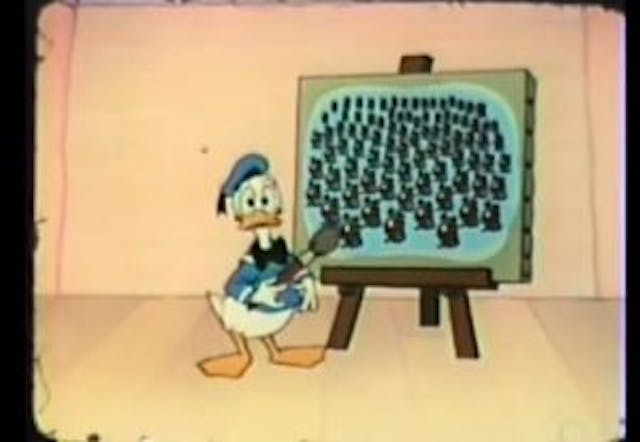
Miracle in Tampa: Florida baby shot in the womb survives
Angeline Tan
·
A newly discovered 1960’s video produced by Walt Disney Productions promotes “family planning” propaganda as a way to solve overpopulation and enter into the utopia that can only be attained by having smaller families. The company known for animated cartoons was started in 1923 by Walt Disney and his brother Roy O. Disney. In 1966, a year prior to the film’s release, Walt Disney died, leaving his brother Roy in charge. The controversial film, entitled Family Planning was released in December of 1967 and produced in association with the Population Council, which advocates abortion.

The Population Council is credited with bringing the abortion pill RU486 to the United States. The organization was founded in 1952 by John D. Rockefeller 3rd.

Frederic Osborn, a founding member of the American Eugenics Society became the group’s second president in 1957. Osborn, who once wrote, “Eugenic goals are most likely attained under a name other than eugenics,” signed Margaret Sanger’s “Citizens Committee for Planned Parenthood” published in her Birth Control Review in April of 1938, as Live Action News has previously documented.
Some speculate that Planned Parenthood’s infamous slogan “Every Child a Wanted Child” may have originated with Osborn.
In 1969, Population Council’s president, Bernard Berelson, published an article suggesting that if voluntary methods of birth control were not successful, it may become necessary for the government to put a “fertility control agent” in the water supplies of “urban” neighborhoods.
The Population Council brags about their Disney collaboration on their website’s timeline noting the film has been translated into 25 languages.

The propaganda film features Disney’s iconic animated character, Donald Duck who introduces the alleged gloom of having a large family. Children, in smaller sized families are “healthy and happy and go to school to gain an education,” the film states, as if, children of large families are unhealthy, unhappy, and uneducated.
The mother of a smaller sized family doesn’t “have to work too hard and stays healthy and happy,” producers of the film go on to claim.
The propaganda film begins by referring to the “Common Man” who “by nature” is “one of the animals.” It states:
But he has something the rest do not have, human intelligence and the ability to reason and plan ahead. Other animals are at the mercy of the world around them. But by his ability to reason man has learned to improve his life.

In what they call an “upward rise” of man, the film’s narrator claims that man is being held back by increased numbers:
But this upward rise is being slowed by the sheer weight of numbers. The family of man is increasing at an astonishing rate. Almost doubling every generation. Ironically, this too comes about through man’s intelligence.
The film takes a slight Malthusian look at population growth blaming the increase in population on medical advances.
“The number of people in the community remained about the same for many generations,” it says. “There was almost a balance. A balance between the large number of babies born each year and the large number of people who died.”
The film credits, disease, epidemics, and famine with the death of earlier generations, until, “[…] in the space of a single generation, man began to change these conditions. There was great progress in medical science.”

Adding, that now (in 1967):
There are still about the same number of babies being born each year but, today, deaths are cut in half, or better especially among children. The old balance is upset. Those who live now, instead of dying, are added each year to the number of people in the community.
The film indoctrinates its viewers that a “happy family” is one with a modest number of children while large families basically starve with “no money for modern conveniences. […] The mother will have too much to do. She’ll be tired and cross and her health will suffer. The children will be sickly and unhappy with little hope for the future.”
This was the attitude Planned Parenthood founder Margaret Sanger once advocated when she suggested that parents get a license to parent.
Article continues below
Dear Reader,
Have you ever wanted to share the miracle of human development with little ones? Live Action is proud to present the "Baby Olivia" board book, which presents the content of Live Action's "Baby Olivia" fetal development video in a fun, new format. It's perfect for helping little minds understand the complex and beautiful process of human development in the womb.
Receive our brand new Baby Olivia board book when you give a one-time gift of $30 or more (or begin a new monthly gift of $15 or more).

In Sanger’s“A License for Mothers to Have Babies” with the subtitle, “A code to stop the overproduction of children,” she writes:
Permits for parenthood shall be issued upon application by city, county, or State authorities to married couples, providing the parents are financially able to support the expected child, have the qualifications needed for proper rearing of the child, have no transmissible diseases, and on the woman’s part, no medical indication that maternity is likely to result in death or permanent injury to health.
Sanger later told journalist Mike Wallace, “I think the greatest sin in the world is bringing children into the world — that have disease from their parents.”
In their January 1968 edition of the publication Studies in Family Planning, Population Council explained why they produced the film:
Throughout the world there is great need for more energetic programs of information and education on family planning. As we have deliberated about the problem, we have considered that one of the most familiar, most popular, and most effective materials for mass exposure is the animated cartoon; and certainly among the leading producers of this form is the Walt Disney organization. Accordingly, the Council authorized the Disney studios to prepare a short color cartoon, featuring Donald Duck, that deals with the desirability of family planning. In addition to the talent and reputation of the Disney studio in this field, the Disney style is familiar throughout the world and its identification with wholesome family life is well-known.
The film is called “Family Planning.” […] The film is designed primarily for men and women of reproductive age in the developing countries of Asia, Africa, and Latin America, and we have reason to believe that it will be utilized in the United States as well.

The goal of the film is then laid out in the article:
The film will, we hope, help to develop attitudes favorable to the small family norm; […] stimulate discussion of the matter; and, importantly, help to legitimate the very concept and practice of family planning throughout the developing world.

To no one’s surprise, Disney’s film captured a version of Planned Parenthood’s oft repeated “every child a wanted child” slogan, mentioned previously as attributed to Osborn.
“This picture can be true for complex families if the number of children born is left to chance! ” the film says.
And the solution?
“Today things have changed,” the film explains, “modern science has given us a key that makes possible a new kind of personal freedom – family planning!”

It’s pure bliss in Disney’s family planning world and there is no mention in the film about the complications of birth control, the unpredictability of pregnancy or the effectiveness of each family planning method.
Nor is there any mention of whether some “family planning” methods could be abortive.
Nope.
Just rainbows and unicorns and of course, Donald Duck and the promise of miraculous results because allegedly “[family planning] improves the health of mother and children” and, as the propaganda film claims, “both are better off if children are not born too close together.”
And, as a reward, for limiting your children you will have room for “modern conveniences.”

The film ends with the concept that family planning will somehow usher in a utopia world which benefits all of society:
[…] if enough couples choose family planning the balance will be restored. But, this time in a better way. Thus, every couple has the opportunity to help build a better life not just for themselves but for people everywhere. And, all of us have a responsibility toward the family of man, including you.
The film is one of many efforts in the 1960’s and 70’s to indoctrinate the culture on the use of birth control. It was sold by Planned Parenthood in certain areas, but went out of production in 1988 because of decreasing demand, according to a report by the Population Research Institute.
Live Action News is pro-life news and commentary from a pro-life perspective.
Contact editor@liveaction.org for questions, corrections, or if you are seeking permission to reprint any Live Action News content.
Guest Articles: To submit a guest article to Live Action News, email editor@liveaction.org with an attached Word document of 800-1000 words. Please also attach any photos relevant to your submission if applicable. If your submission is accepted for publication, you will be notified within three weeks. Guest articles are not compensated (see our Open License Agreement). Thank you for your interest in Live Action News!

Angeline Tan
·
Abortion Pill
Carole Novielli
·
Investigative
Carole Novielli
·
Human Rights
Carole Novielli
·
Abortion Pill
Carole Novielli
·
Investigative
Carole Novielli
·